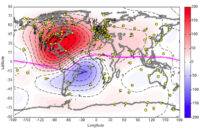A picture of the rocket plumes shortly after the launch of both Dynamo rockets from Wallops Flight Facility on July 4, 2013. (NASA/JAXA/R. Pfaff et al/Ken Kramer)
Home A picture of the rocket plumes shortly after the launch of both Dynamo rockets from Wallops Flight Facility on July 4, 2013. (NASA/JAXA/R. Pfaff et al/Ken Kramer) A picture of the rocket plumes shortly after the launch of both Dynamo rockets from Wallops Flight Facility on July 4, 2013. (NASA/JAXA/R. Pfaff et al/Ken Kramer)




